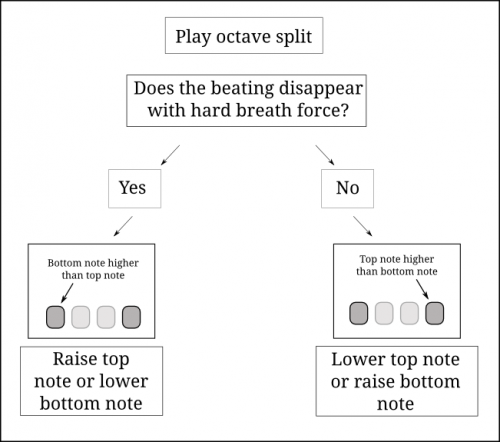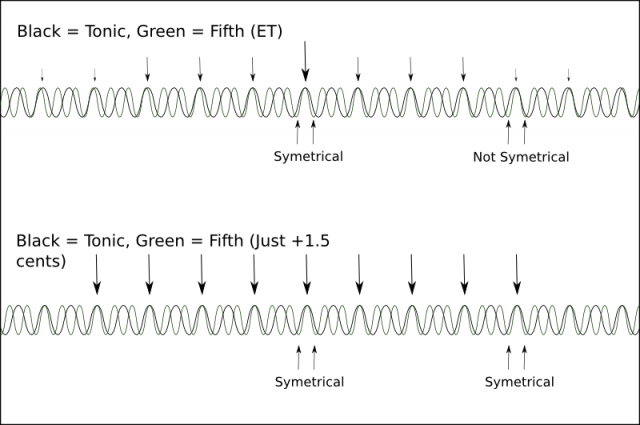This is part of a series about tuning the diatonic harmonica
Part 1 - Tune a harmonica using your ears and a simple chromatic tuner
Part 2 - More Better - ultra precision tuning
Part 3 - Perfect Pitch: Using breath dynamics for tuning
___________________
The diatonic harmonica can be tuned to different temperaments.
Equal temperament is when each note is tuned to its exact pitch. When the notes of a chord are played together at ET, the chords can sound dissonant because the harmonics aren't in sync. Just intonation means some of the pitches are tuned a little sharp or a little flat so that when played together, the chords sound very smooth. The harmonics are in sync.
Here is a diagram of the waveforms of the tonic and third superimposed:
On the top, you can see that at ET, only one cycle is in sync. On the bottom at JI, every fourth cycle is in sync. That note needs to be 13 cents flat to sync up.
Here is a diagram of the the waveforms of the tonic and the fifth superimposed:
On the top line, at ET, only one cycle is perfectly in sync and we can see it rapidly go out of sync as you move away from the center. On the bottom line, every third cycle is in perfect sync. The interval of the fifth is a powerful sound (guitar players call it a power chord!) because the waveforms are in such harmony. But it only took 1.5 cents to disrupt the timing and make it sound less powerful.
There is no way you can tune a diatonic harmonica to within 1.5 cents accuracy by looking at the needle on a chromatic tuner.
Why?
Harmonica reeds don't always vibrate at the right pitch. If you apply too much air flow, the reed will vibrate too slowly and the pitch will go down. The note will sound flat. That's because you are making the reed move a lot further that it is designed to do (greater amplitude) and it has to travel a greater distance with every vibration.
Likewise, if you play the reed with much lower breath than intended, it will hardly move. Since it will only travel a short distance, it will make the trip is less time and the frequency will go up - the note will sound sharp.
Fortunately, there is a very large "sweet spot" where the reed responds to a range of air flow and can stay reasonably on pitch - within a few cents - even if you don't always use the same breath force to play that note. That's why we can play the diatonic harmonica with such a large range of dynamics.
The fact that the pitch varies by a few cents with breath force is both a curse and a blessing when it comes to tuning.
It's a curse because you can't just tune each hole to a specific note. You need to offset the tuning of each reed so that you meet the following criteria (to name a few):
- the single notes are on pitch
- octaves are on pitch
- the other intervals (fifths, thirds) are on pitch
- the three blow and two draw are enharmonic equivalent (the same note) but they are not the same note (blow three is a fifth, draw two is the tonic; each one has a different offset.)
To meet all these criteria you need high precision. That's where using dynamics actually comes in handy.
Longer reeds flatten more than shorter reeds as you increase air flow. When you play two reeds at the same time you can count on the lower reed to flatten more that the top reed as you increase air flow (because it's longer).
So if two reeds are very close to being in tune, say, they both register the same on the chromatic tuner but you hear beats when you play them together, you can tell which one is tuned higher by playing with increased breath force and listening to what happens.
- If the beating slows down or disappears when you increase air flow, the bottom note is a little sharp.
- If the beating gets worse with increased flow, the top note is a little sharp.

Here's another way of looking at it. This is an animated GIF of two waveforms superimposed. The waveforms are an octave apart. Both waveforms lengthen (drop in pitch) as breath force increases. The lower note in the octave is sharp but with increased breath force it goes into tune with the higher note for a short moment.
In this case, we should either tune the lower note a little sharper or flatten the higher note.
The effect of flow rate on pitch

Here's an example of using breath dynamics to tune with precision:

